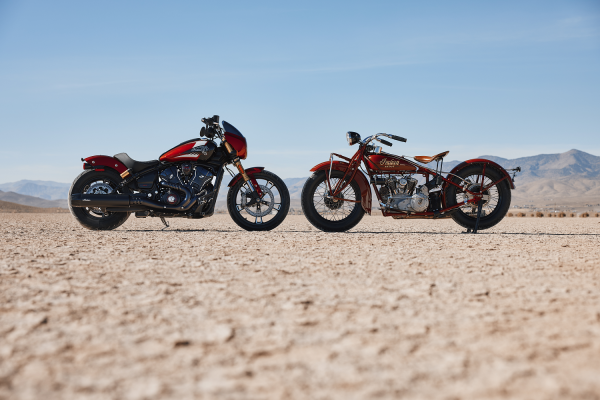Who Invented the Motorcycle?
The history of the motorcycle goes back a fair way, but where, and, perhaps more importantly, with whom, does it actually begin?

Member for
54 years 8 monthsIf you were to ask Alexa for an answer to the title of this light dive into motorcycle history, you’ll probably have her pipe up and claim that the Daimler Reitwagen, created by Gottlieb Daimler and Wilhelm Maybach in 1885 are responsible, but she’d be on very thin ice.
The problem is that the Daimler Reitwagen, which literally translates as ‘riding car’, isn’t technically a ‘cycle as it consists of two large wheels and a pair of smaller stabilising wheels, suggesting that the name ‘Reitwagen’ is pretty much on the money.
And without wishing to labour the point, save the addition of the newly invented internal combustion engine, it shares none of the dynamic characteristics of a motorcycle either as some of the essential aspects of what we associate with riding a motorcycle -namely balance and the gravitational/centrifugal forces analogous with lean angles- are notably absent. Frankly, the modern motorcycle has more in common with ‘the Swiftwalker’ of 1817, another German invention courtesy of one Karl von Drais, who is credited with kickstarting (if you’ll pardon the pun) the concept of the modern bicycle.
2025 Indian 101 Scout with original 1920s Scout.
The Swiftwalker didn’t have pedals, let alone a fancy internal combustion engine (that arguably arrived in 1860 courtesy of Belgian/French engineer Étienne Lenoir) but more of the physical dynamics we take for granted when popping over to the Ace Café for a mug of tea that’s hotter than the melting point of diamond are present and correct. Putting that into some sort of context, if we attempted to navigate a bend on the Swiftwalker (while taking into consideration the iron rims and leather tyres) we'd fare better than wobbling atop Daimler's Riding Car because we all know what happens if you go around a corner too fast on stabilisers, kids.
Of course, no one is suggesting that what is essentially a child’s balance bike was the first motorcycle because it doesn’t have an independent power source. Technically speaking the ‘motor’ aspect of ‘motorcycle’ is, by definition, “[a machine] powered by electricity or internal combustion”, not by other means, such as steam, which is a shame because if we go a little further back to, say, 1867, we would have had a robust contender for the first motorcycle known to humankind.
Around the same time as Lenoir’s combustion engine was making its debut, Pierre Michaux, a French blacksmith often credited with the invention of the pedal bicycle or velocipede, unveiled his steam-powered bicycle after his son, Earnest, who thought it’d be well gnarly to fit a steam engine to one of his father’s inventions. By the way, we’re fully aware of a handful of similar concepts unveiled at pretty much the same time, such as the likes of Sylvester H Roper’s Columbia bicycle, so don’t write in.
The point here is that the steam-powered cycles were closer in spirit to the motorcycle as we know it today, not only did they have two wheels and an engine, but they were also much faster also. Before he was killed in 1892 while cheerfully demonstrating one of his steam-propelled creations, Roper was clocked riding at 40 mph, which is almost six times faster than Daimler’s Reitwagen (top speed: 6.8 mph), but there is still something more fundamental missing in all the aforementioned examples, a fourth component (outside of two wheels, engine and speed) that’s crucial to motorcycles.
Handling.
Being able to negotiate corners without having to remain bolt upright on account of stabilisers/leather tyres is as much a part of motorcycling as nodding to a fellow biker on a Sunday. So, it’s fair to say that, until the invention of the pneumatic tyre, the motorcycle was still in the latent stages of labour before birth.
We’ve two Scottish legends to thank for pneumatic tyres: Robert Thomson, who discovered vulcanisation when he added sulphur to rubber in 1839, and John Dunlop, who essentially popularised his version of the same concept when they became a standard feature of the motor car in the late 1800s. Our debt of gratitude goes to Félix Théodore Millet who, in 1892, fitted his eponymously-named rotary-powered motorcycle with a pair of pneumatic tyres, changing the proverbial game forever.
This was the dawning of greater speed in corners, less slip under both braking and acceleration, all aided by a ride that wouldn’t shatter your spectacles. One might even tentatively argue that the invention of the humble Millet was the moment the motorcycle as we know it was born... But it doesn’t work like that.
No one person invented the motorcycle. The machine as we know it today evolved in various sheds, garages and workshops all over the world, it was a united effort overseen by free-thinking individuals who were simply more interested in going fast than staying dry. Every day is a school day, Alexa.
.jpg?itok=UW0pzzVl)










